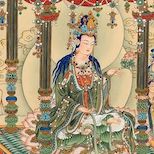Jodo Wasan 112
He addressed the World-honoured one, the master of the teaching,
'Ages ago, kalpas countless as the Ganges' sands in the past,
A Buddha appeared in the world
Whose name was Immeasurable Light.'
Time and the Dharma

The Buddha Dharma offers us a single proposition: that it is possible for us to attain a state, which is unlimited by space and time. Although different schools of the dharma support a variety of doctrines about the reality of time and space, certainly they are a synonym for samsara - and they are also co-relative terms. For that reason there is an on-going development of thought about time throughout Buddhist history. The Sarvastivadins saw time as real, while the Sautrantikas did not.1
When Mahasthamaprapta tells Shakyamuni, then, that he can recall events which occured 'as many kalpas ago as the Ganges' sands' just what is he telling us?
A kalpa appears to be a unit of time, but it is not time divorced from other phenomena. As difficult as we find this idea, it seems to me that, unless we make the effort the free ourselves from our prejudices and think out the implications of what is taught in the sutras, the saving significance of the dharma will elude us. In some important Buddhist documents - the Abhidharmakosha, for example - it is true that an attempt is made to calibrate it as a form of linear time. However, kalpas are more often described in extremely imaginative and colourful ways. One of the most famous of these is the suggestion that it is the length of time it would take a sparrow to wear down the Himalayas by brushing its wing against them once a year.
The sutras also often describe time as entirely subjective. A life-span can be seen as a unit of time, even though there is a big difference in the calibrated lengths of the lives of different species. For a god, a day is fifty human years; a dog only lives an average life of around eighteen years; we humans live an average which varies between rich and poor countries; and in east Asia it is commonly held that cranes live for a thousand years. It is difficult for us too see these varying life-spans as a single unit because of the way we measure things. A kalpa then, in terms of measurement is actually incalculable - not only because it is very long but also because it means different things to different forms of existence.
When the sutras discuss time, it is origins that we are speaking of. We are learning of those things which framed the world as we know it but which are too deep to recall or to remember. This idea is held in common with our actual experience as individuals. I certainly cannot remember any events before my birth and certainly nothing of my life in the womb. Worse, few adults can remember their childhood in any clear and reliable detail. Yes, it is true that a miscellany of people, places and events float in and out of our memory but they are rarely accurate in forty-eight minutes, yet we are accounting for some seventeen years or more.
These unclear and uncertain events are the story we tell in giving an account for the way we are now. Mahasthamaprapta likewise is talking of his origins, not so much as he passes through a tunnel of recorded historical events but as he gives an account of what it is that made him the bodhisattva that he is now. He is not calling things up from a list of past events but from a deep repository of inner truth.
The past, from the point of view of the dharma, tells us not of events but of what it is that constitutes the present reality. The story of Amida Buddha's Vow is not telling us about history but what it is that constitutes Amida Buddha now; what it is that motivates him. History in the dharma is a matter of depth, rather than the progress of time. You will notice, in reading the sutras of both the Pali and the Mahayana canons that explanations of the past are only revealed subjectively. Whenever Shakyamuni speaks, he speaks from his own internal and enlightened memory. He is not recounting events in the way that a modern historian does - as a putative objective account, supported by written contemporary documents.
We have to ask ourselves, then, why it is necessary to put these things into an historical framework. The answer is simple. The only way to reach into the consciousness of a deluded person is to speak in terms of the delusion; the only way to converse with someone is to speak their language. In conceding the ingrained nature of our belief in time we are hearing things in our own terms; in ways that we can understand. In teaching the dharma, the Buddhas speak not to themselves, but to us.
1: That is, according to the Satyasiddhi Shastra of Harivarman (approx. 2nd Century), which is reputedly a Sautrantika document. Sautrantikas were one school among the early 'eighteen nikayas' or branches of the buddha-shasana (the Buddhist community, culture or movement).